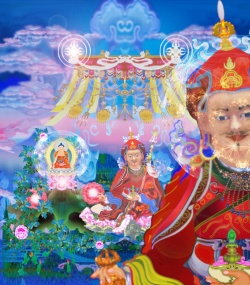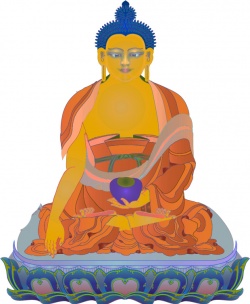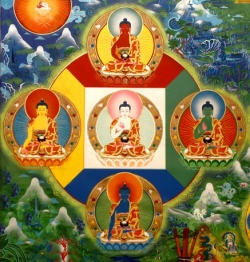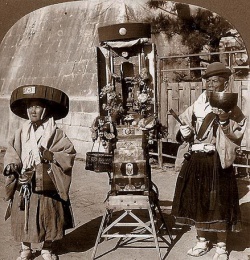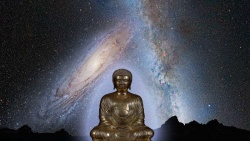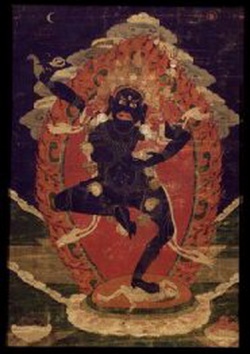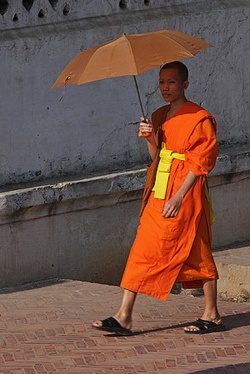Relating to the Tibetan Buddhist Shrine
This Excerpt is from Khenpo Karthar Rinpoche’s “A Teaching on the Shrine”
Acknowledging that we are all capable of developing and flourishing, Rinpoche will discuss how we, as Dharma Practitioners should relate to given circumstances in order to enhance our growth potential.
Generally speaking, in different countries, among different people, we find different customs, different cultures. Ultimately, these cultures are not necessarily that important in that they are not particularly beneficial. Not that they are completely insignificant, for they do some of what is unique about that specific population. And even if they lack qualities of growth or sanity, this does not mean that they are in any way harmful. In Tibet, for instance, a customary way of showing respect is to take off your hat to someone. This gesture is not particularly beneficial to anyone involved, yet, if you really have respect for this person as a human being, it is good for you to be able to relate with dignity to someone in that way. By showing respect for others, you show respect for yourself. From that point of view, this custom makes perfect sense.
A great deal depends on whether it’s just a cultural trip or if you’re really able to put some meaning into it; if you’re just adopting somebody’s culture, it wouldn’t make much sense. For example, in India, as a sign of genuine respect a person will get down and touch the feet of an elder or superior, and then touch the crown of their own head in the same gesture. In this way, the lowest part of the other person’s body is equated with the highest part of their own, affirming the reverence they feel towards that person. Such an expression of respect and humility towards a person you feel is deserving can be extremely worth while. But again, if one is merely “trying on” new cultures, not understanding what one is doing and remaining reluctant and uptight about it, there is no real benefit in doing it. Instead, internal conflict may result because once the infatuation with the surface charm has worn off, then that’s it, and one is left feeling disappointed.
Similarly, when dealing with a shrine, the unfortunate possibility exists of it merely becoming a collection of dharma objects, like an entertaining and exotic exhibit. As a result, others will also see it as a show, something that’s pretty interesting, a “never-seen-that-before” kind of thing. In the end, one relates to the shrine as if it were any other mundane object.
Another possibility is of making larger offerings on the shrine than is appropriate. According to Rinpoche, if you visit an aristocratic or noble family in Tibet, you may find their shrine to-be quite ostentatious, as if it’s there merely for people to notice how many precious things they own. This is typical of the spiritual-materialism we are all susceptible to, where all religious appreciation is based on infatuation and ego-glorification.
Now, in terms of placement of the shrine, according to the teachings of the Buddha, it should be in a place where there is no fear of danger or great disturbances. If you should be in a place where there is much fighting or if the premises are owned by someone who can tell you to leave or not to practice there, then there will be no true sense of refuge or openness. Once you have found a place free of such hindrances, it is important that it be kept as clean as possible. Just as you like to keep clean in order to feel more comfortable and to relate to yourself better, it’s the same with the shrine. A neat and ordered environment can be very inspiring, especially for beginning dharma practitioners. This is very important, because initially, there are predispositions involved. If one were an advanced practitioner, then one’s internal relationship to the enlightened objects of refuge would take precedence over their condition or placement. One would be relating to the internal order, and the external arrangement would be irrelevant. For beginners and most people in general, however, this is not the case, so it is important to set the groundwork concerning the shrine area.
There are no specific measurements for the height and width of the shrine; this will pretty much depend upon the space available. Generally, it should be as well-built and dignified as possible, and the higher, the better. As for the precise construction, the shrine should have an odd number of tiers: either one, three or five. If the shrine has three tiers, it can be seen as an offering of one’s body, speech and mind to the body, speech and mind of the buddhas or enlightened objects of refuge. Having offered these, or having offered one’s clinging to the idea of a personal self, then one also realizes the body, speech and mind of the awakened ones, or rather, one experiences an equal realization. If a shrine has five tiers, it can be seen as a symbolic rendering of the Five Buddhas or the five enlightened aspects of the mind. In this way, it serves as a reminder of the awakened state of mind towards which we aspire. When there is only one tier, it signifies that there is only one ultimate fruition, the perfect awakened state of the mind. The one tier or set of offerings therefore already embodies the three and the five.
On a five-tiered shrine, the first and highest level should hold whatever symbolizes the enlightened objects of the refuge: the statues or scrolls of the buddhas and bodhisattvas and great teachers, and the texts of the teachings. The second, third and fourth layers should each hold a set of offerings, collectively known as the offerings to the three roots, namely: 1) the outer offerings, made to the gurus or to the highly enlightened teachers who are the actual sources of one’s understanding;
2) the inner offerings, made to the yidams, the deities of practice who are, in essence, the embodiment of the teachings and the accumulation of the dharmas; and 3) the secret or ultimate, offerings made to the bodhisattvas who manifest themselves in different forms as the protectors of the dharma. Generally; these offerings are used only in more advanced practices and detailed explanations will be made as you are introduced to them. Finally, on the fifth and final level, one places general offerings of food and drink. By making these offerings, by extending our liberality, it is possible to accumulate enlightened qualities and purify the habitual tendencies of desire and greed.
Whatever statues, pictures or paintings are used should be as clean and as well-made as possible. If instead they are of varying shapes and all out of proportion, the shrine will be more a reflection of one’s psychological patterns than anything else. In terms of skillful means, this is exactly what you don’t want to do, because when other people look at it, especially those unfamiliar with the practice, it will not create a positive impression – perhaps they will just laugh and say “Oh, that one looks something like that kind of thing!” Having a decent set of statues and pictures and arranging them in a neat and orderly manner is quite important. Looking at these representations of the buddhas and bodhisattvas and enlightened deities should bring inspiration and upliftment and should orient one to the responsibility of practicing the Dharma.
Essentially, the shrine should be as beneficial to oneself and to others as one can make it. Not that the buddhas and bodhisatwas are going to care if you have oddly shaped representations of them, but as far as you are concerned, this would definitely show ill-discipline. In the same way, the offerings should be neat and clean and properly placed in line. In fact, the whole reason one correctly attends to and relates to the shrine is in order to practice the six perfections. When the environment is properly arranged, it feels good to be there and it’s a very healthy place. Through the offerings of clean water and clean bowls and the mental offering of a genuine purity of mind, one is, in reality, working on the perfection of discipline. The nature of discipline is purity and freedom, and by expressing it in this way, one perfects these qualities.
In addition, when making the offerings of the different objects, such as the incense, flowers, lamps, food, etc., they should be done with a sense of genuine hospitality to rid oneself of the pattern of greed and of miserliness. Whether making a large or small set of offerings, they should be put forth sincerely and wholeheartedly, without hesitation. In this way we relate to another of the six perfections, the perfection of generosity. These offerings should be made joyfully, so that one gladly spends whatever time is needed to attend to it. If one does it unwillingly, thinking about something that needs to be done, and taking it as a burden, this shows a lack of patience.
If, however, you take the time to care for and relate to it properly, you will be practicing the perfection of patience. Furthermore, the offerings should be made consistently, day in and day out, not merely when you feel excited about it. By maintaining this undeviating devotion, one also lays the foundation for the perfection of diligence. In the same way, when making offerings, one should always be mindful of what one is doing. For instance, if one is pouring water in the water bowls and some are overflowing, some are half-fuIl, and some are barely filled or missing, this reveals a lack of mindfulness. By making sure that each one has just enough, and all are appropriately placed, one relates to the perfection of meditation.
Ultimately, these offerings are made to the enlightened objects of the refuge for the benefit of oneself and all beings, to cause the accumulation of meritorious qualities in all beings. In effect, these efforts are made for the liberation of all beings from their egoistic patterns which trap them in cyclic existence. This embodies the practice of the perfection of wisdom.
Whatever offerings have been made, large or small, one should desire that they symbolize and embody all worthy objects of offerings. And if one dedicates the benefit towards the liberation of all beings, it becomes inexhaustable-such benefit cannot be fully destroyed no matter how strong the karmic patterns of individuals may be. In this way, making the offerings and relating to the upkeep of the shrine is an important method of relating to the development, and ultimately the perfection, of wisdom.
Having attended to the offerings, it is important that mindfulness of the relationship be maintained in the course of the day as well. It is very good to attend the shrine in the morning with a wakeful attitude, sincere intentions, and good spirits. But, if in the course of the day, as one is feeling tired or feeling lazy, one puts a hat on it, and maybe a pair of gloves, and even a pair of stinking socks, it’s not quite so good anymore. Although there may be no negative intentions, there is a lack of mindfulness and of decency.
We know from our daily routine that only certain things go together or else there is a mismatch. There is still merit accumulated from having made offerings, and from having a shrine and so on, but that benefit is destroyed or diminished by one’s laziness, carelessness, and lack of mindfulness. It is as though you have made a good painting with your hands, but you step on it with your feet, and it becomes worthless. As you can see, it is vital that one maintains mindfulness of the shrine’s proper condition.
All told, there are several different sets of offerings, and as you relate to more advanced practices concerning specific deities, you’ll be making specific offerings, set out in certain ways and directions. These will of course be gradually introduced to you. At this point in time it’s important to know the seven or eight basic offerings. Whether it’s one’s personal shrine or the center’s shrine, it should have at least these seven sets of offerings to whatever images of buddhas and bodhisattvas and deities of practice that one has.
To begin with, the first two offering bowls should contain water (if it’s available, one might add some saffron to them for greater purity, otherwise just use clean water). In the remaining five bowls are placed the following items respectively: a flower; some incense; a lamp; another water offering; and a food offering.
The first bowl of water is an offering of drinking water to the buddhas and bodhisattvas. Although enlightened beings have no need for such, and would not be excited or disappointed if we offered it or not, we do this for the accumulation of meritorious qualities. Also, this simple offering is made before the compassionate buddhas and bodhisattvas so that in those realms where beings constantly suffer from thirst, there may be water to alleviate their suffering, and ultimately, that the water of the dharma will alleviate the sufferings of all beings. Therefore, with an understanding of this twofold meaning, one makes this offering very sincerely.
The second offering bowl is for the bathing water. Again, it’s not that the buddhas and bodhisattvas have need for such a gift. Rather, for the benefit of oneself and all beings, one requests the buddhas and bodhisattvas to accept such offerings so that the karmic patterns of all beings may be cleansed.
In the third offering bowl, one makes offerings of flowers to the eyes of the buddhas and bodhisattvas. As before, the offering is not made because awakened beings have attachments to beautiful flowers. Instead, the offering is made so that all beings may temporarily experience higher realms of existence. One hopes that eventually all beings will experience the buddha-body, the immaculate body which engenders all the marks and attributes of a perfect awakened being.
The incense of the fourth bowl is offered to the buddhas and bodhisattvas in order to eliminate the unwholesome smell of beings. This does not necessarily refer to earthly tastes and aversions, but to what you might call the distinctive odor of ill-discipline. A bodhisattva who has experienced the perfection of discipline will emanate a perfume or profound fragrance all the time, despite the washed or unwashed condition of the clothes or body.
Furthermore, if a bodhisattva stays in a particular house, it will seem as if incense has been burned every day for months and even years afterwards, even if no incense has been lit and no artificial perfumes have been used. Therefore, in order for all beings to experience the perfection of discipline, one makes this offering.
The offering of the lamp is made so that, temporarily, it may cause the experience of relative wisdom to arise among beings. One hopes that all beings will be able to discern what is proper and beneficial to themselves and to others. In this way, whatever undertaking one makes is not wasted because one can relate to it with wisdom and intelligence. So, towards the accumulation of these qualities, and towards the ultimate realization of the awakened state without limitations by all beings, one makes the offering of light.
The sixth offering is composed of the perfumed or scented water used after bathing. Since the buddhas and bodhisattvas experience the pervading fragrance of the perfection of discipline, they have no need for artificial fragrances. However, one makes the physical offering so that all beings may experience that awakened psychological state cognizant of the natural purity, perfection and pure-scent of all things- As a result all things encountered have the most soothing and enlightening smell and radiate goodness.
The seventh bowl contains the food offering. Basically, any kind of food will do, as long as it is suitably clean. This offering is made so that, temporarily, all beings suffering in realms of starvation and hunger may be endowed with food and all else they need. Ultimately, it is hoped that all beings will have the capability to live on the food of meditation.
The eighth offering is the offering of music and this is made by placing on the shrine a bell or a specific source of music used in practice (if the practitioner is using the instruments in the practice, they do not have to be on the shrine all the time). Through offerings of pleasant sound and music we accrue merit for ourselves and all beings, and ask that all painful, irritating and harmful sounds causing fear and frustration among beings be eliminated. And consequently, may the self-sounding nature of the dharma pervade all beings.
Thus, this set of offerings is what might be called the actual offerings. As such, they embody all other worthy objects of offering, meaning that one could, along with these offerings, also make imagined offerings. With the offering of the drinking water, for instance, one simultaneously makes an imagined offering to the buddhas and bodhisattvas of all the pure water throughout the world. This is done so that the goodness of the dharma may permeate all beings. For similar reasons, when one offers the flower, one also makes an imagined offering of all beautiful, desirable objects and forms to the buddhas and bodhisattvas.
With the offerings of the incense, one also offers to the enlightened agents all elements of perfection generated by beings exercising immaculate discipline. Furthermore, the offering of the lamp incorporates all forms of light – the light of the sun, the moon, the stars and of all illuminating objects. The totality of all these lamps and lights is offered to the buddhas and bodhisattvas for the benefit of all beings. With the perfumed water one mentally includes in the offering everything that has a profound and attractive fragrance. With the food offering all forms of good and nutritious food found in the world are offered. Finally, one offers not merely the symbolic music of the practice, but also all the pleasant sounds and music that pervade the world.
When making an offering, it is essential that one is immersed in what one is doing, and that one maintains a very personal sense of the presence of the buddhas, bodhisattvas, enlightened masters of the lineage, and deities of practice. It shouldn’t be just a routine thing and a burden, like “As long as I show up and keep the boss satisfied, it’s alright.” Relating to these responsibilities gladly and a with a sense of openness at all times seems to be extremely important.
Basically, as a practitioner of the dharma, integrating wholesome actions, attitudes and disciplines and letting go of harmful and unwholesome actions and attitudes is what the practice is all about. Any wholesome discipline one uses will enhance one’s practice. From that point of view, discipline is not restriction but freedom, discipline is sanity. One comes to the shrine room with the proper attitude and with the appropriate clothing, being mindful not to do anything unwholesome, anything negative.
Of course, one should be mindful at all times, because the practice of the dharma is definitely a way of life. The point here is to begin to take a more dignified outlook and to develop a more uplifted state of mind. This is why we sit in this particular position, not stretching out or lying down as we might do somewhere else, but cultivating a sense of control and seeing ourselves as controllable beings. This is also why we do not take intoxicants or smoke in the shrine area. These things are not technical rules, or laws, in the sense that I tell you to jump and you ask how high.
After all, when it comes down to the question of what the benefit or the harm actually is, there is really neither benefit nor harm. In this particular situation, one does not practice discipline because somebody has told you to, but because if these beneficial things are correctly practiced, they become expressions of true freedom and sanity. It wouldn’t make sense at all if you felt as if somebody was merely burdening you with restrictions, because there would be no benefit even if you were to follow such discipline. After awhile you would just feel more disturbed. Physically, you may be sitting in the shrine doing all sorts of things, but in reality you’d be somewhere else, in a completely different realm. Learning to do something correctly, both physically and psychologically, is the essential point here.
In terms of the representations of the enlightened objects on your personal shrine, you should use those objects to which you best relate, as well as the specific objects with which you have had personal instructions to work. The simplicity or the elaborateness will depend on what you can personally accommodate as well as what you have an understanding of.
In a dharma center, it will depend on the school of practice. Anything that symbolizes the Buddha, such as a scroll, thanka or statue, would be suitable for a shrine in any Buddhist school. The other representations, such as those of the bodhisattvas, deities, and enlightened masters, will of course vary from school to school. For instance, the Kagyu school will have different lineage masters and protector deities than the other three schools: the Geluk, Sakya or Nyingma. Just throwing together all kinds of objects would be more like having a collection of religious art, and it might then be difficult to relate to them and have a full understanding of them.
In speaking about the representations of different enlightened objects, we should also mention those deities and bodhisattvas who manifest themselves in different forms for the accomplishment of buddha activities. No matter what appearance or method they utilize, whether they appear in wrathful or peaceful forms, or whether they use direct or indirect means, their use of skillful means is always for the benefit of samsaric beings.
To make an analogy, in our everyday situation there are certain actions we completely and sincerely wish to accomplish, yet sometimes we have to do those actions in a humble, low-profile manner, and sometimes we have to appear confident and self-assured to show that we are capable of doing them well. This is, in a sense, similar to the differing forms the deities must take. No detailed explanation can be given at this point because this is the beginning stage. What is needed now is an orientation to the forms, and then gradually to the meaning, and then to the ultimate meaning
